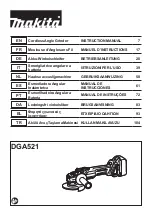
49
Instruction and maintenance manual
ENGLISH
3.3.1 Contact surface
The condition that provides the highest resistance to
the forces generated during machining is achieved
when air gaps are reduced to a minimum and there-
fore the contact between the surfaces is continuous.
The worst results are achieved with an air gap and a
minimum contact.
100% = Optimum clamping
60% = Very good clamping
40% = Satisfactory for some operations
20% = Sometimes sufficient for light grinding
operations
Contact
surface
Contact surface
Surface to machine
3.3.2 Superficial finish
The machining operation is also influenced by the
superficial roughness of the part to machine. A good
contact surface with the magnetic chuck significant-
ly reduces air gaps and thus ensures a consistent
clamping force.
100%
= Grinding
90 ÷ 80% = Fine milling
80 ÷ 70% = Milling
70 ÷ 60% = Not machined
100%
90%
90%
80%
80%
70%
70%
60%
Contact
surface
Grinding
Fine milling
Milling
Not machined
3.3.3 Material used
Always check the material of the part that has to be
machined in order to verify that it is magnetically
conductible. The most conductive material is mild
steel. The following reduction factors apply to other
materials:
100%
Mild steel
70 ÷ 80% Alloyed steel
50%
Cast iron
20%
Nickel
0%
Non magnetic stainless steel, brass and
aluminum
3.3.4 Conditions of the part surface
Superficial heat treatments change the physical
structure of surfaces and consequently also influ-
ence their capacity of absorbing magnetic flows. An-
nealed materials provide higher performances. Tem-
pered materials are unable to satisfactorily absorb
the magnetic flow and tend to maintain a certain
degree of magnetism even after the chuck has been
disabled (DEMAG), to the point that it is sometimes
difficult to detach the part from the magnetic chuck.
Residual (or absorbed) magnetism can be removed
by using a demagnetizer.
3.3.5 Thickness of the part
The flow follows a semicircular path inside the part,
which originates from the center of the pole, moves
towards the magnetic chuck and reaches the center
of the subsequent one.
If the part is smaller than this radius, the part of
the flow that it is output may disperse and cannot
therefore be used to clamp the part. Consequently,
the resulting attraction will be smaller than the one
achieved when you machine a part with a thickness
that is able to absorb the whole flow.
1) Always check the thickness of the part to ma-
chine.
If the thickness is insufficient, you will notice resid-
ual magnetism on the surface opposite the contact
one, along with lower performances. The whole flow
output from the magnetically anchored part is dis-
persed.
The depth of the magnetic flow varies according to
the model of magnetic chuck.
However, as a general rule parts with a small thick-
ness require the use of poles with a smaller section.
The magnetic clamping section of a system with
square poles is equivalent to one fourth (1/4) of the
side of pole (if the part covers at least 4 poles ar-
ranged in alternate configuration, to the side of the
pole (if the part covers at least 2 poles in sequence)











































